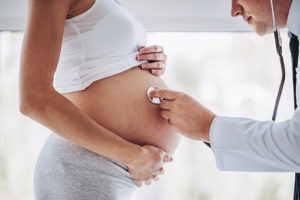
Pregnancy is a time for joy, anticipation, and more than a little stress as women monitor certain health conditions like gestational diabetes, pre-eclampsia, high blood pressure, etc. My intention here is not to add to that worry with talk of hernias. Rather, it’s to put your mind at ease that hernias experienced during pregnancy are very routine, manageable and just another “bump” in the road toward parenthood.
Does a Hernia Put the Baby at Risk?
Since this is the #1 concern with expecting parents, it’s best to answer the question right up front – and the answer is “No.” If mom has a hernia with symptoms occurring under the skin, that baby is safe and sound deep in the uterus without any inkling that something is happening elsewhere.
A Hernia Explained
Imagine holding an inflated balloon in your hands. Think of the balloon as your internal tissues and the fingers on your hand as the muscle fibers of your abdominal wall. Press the balloon into your palm and open up a gap between two fingers. The balloon begins to protrude through that gap. That’s exactly what happens with a hernia, as weaknesses in the abdominal wall allow some of your insides to come out.
How Pregnancy Can Relate to Hernias
A woman’s midsection gets bigger and bigger as pregnancy progresses – we all know that. While this is happening, the abdominal wall stretches. This can reveal weaknesses that cause one of three types of hernias.
1. Umbilical Hernias
This is the most common and non-alarming type of hernia during pregnancy. It happens right at your belly button. Usually, a small amount of internal abdominal fat, rather than intestines, bulge through the front of the abdominal wall. It basically turns your “innie” navel into an “outie.” Umbilical hernias during pregnancy cause tenderness to the belly button area. They are mildly inconvenient, yet do not often require medical intervention.
2. Periumbilical or Epigastric Hernias
This type is similar to the umbilical hernia, but happens near your navel and not directly at the belly button. They are usually caused due to weakened abdominal tissues and are common after pregnancy. Periumbilical hernias may induce more significant swelling and may appear very large. Surgical intervention may be necessary if your physician suspects that the hernia has a risk of strangulation.
3. Inguinal Hernias
This is the least common hernia type in women, occurring lower in the groin area where muscles and abdominal wall fibers can stretch due to uterine pressure. Inguinal is the hernia mostly experienced by males.
Hernia Symptoms During Pregnancy
If you have a hernia, you’ll probably notice a soft lump at or near your belly button, or sometimes in the groin area. A dull ache often accompanies the hernia, and it will hurt more when you’re active or if you cough, sneeze, laugh hysterically or bend over.
If your hernia doesn’t cause severe pain or protrude excessively, it will likely repair itself after labor. However, if it begins causing intense pain or sticks out further as time goes by, it may indicate that the hernia has become “incarcerated” or trapped in the abdominal wall. If left untreated, these hernias can very rarely damage your intestines. So, if it hurts a lot, please call your doctor. Also, if nausea and vomiting coincide with a painful hernia bulge that’s red and tender, a trip to the Emergency Room is required.
Hernias During Labor
Most women with hernias can have normal vaginal deliveries. On rare occasions, a hernia can appear during or immediately after labor. This is due to the abdominal pressure required during labor as women push a baby out. If it happens, the physician will assess the proper course of action based on the severity of the hernia.
Are Some Women More at Risk?
Most hernia defects are congenital and present at birth. They’re not noticeable until the hernia defect expands during pregnancy. For others, there are certain factors that can make hernias more likely. They include:
- Carrying multiples babies
- Prior pregnancies, especially those involving long labors
- Having had a previous hernia
- Obesity
Hernia Treatment During Pregnancy
In most cases, doctors will recommend keeping an eye on the hernia without any treatment. If the bulge is bothersome, women can wear a belly band to hold it in. Icing and massaging the hernia back in towards the stomach is also effective.
After labor, there are exercises that help abdominal muscles heal from the strain of pregnancy. If the hernia hasn’t repaired itself after a recommended amount of time, surgery may be considered a few months later.
Surgery during pregnancy is only recommended if the hernia is strangulated, which is rare. Most of the time, hernia repair can wait until after delivery. Options for surgery include mesh or no mesh repairs, depending on the individual patient. If you think you may have a hernia that will require surgery, schedule an appointment with our expert team to come up with an individualized treatment plan.

